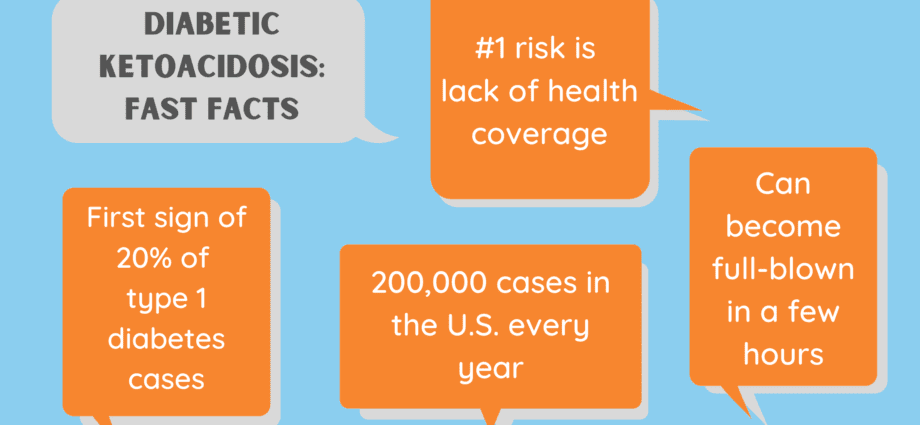Contents
Diabetic ketoacidosis: definition, symptoms, emergency treatment
What is diabetic ketoacidosis?
To understand diabetic ketoacidosis, it is first necessary to know that glucose is the main fuel of our body. When the body is lacking, for too long, it instead draws from the fat reserves so as not to be lacking in energy. When there is not enough insulin in the blood, which is sometimes the case in people with diabetes, the cells can no longer use the glucose present in the blood. Because insulin is a hormone – naturally secreted by the pancreas – which helps bring glucose into the cells of the brain, adipose tissue, the liver and skeletal muscles. It therefore maintains blood sugar at normal values.
The acidocétose
When the insulin shortage is severe, the body, instead of using glucose, is forced to use fat for energy. It works, but the problem is that breaking down these fats makes ketones, or acetone. However, these ketone bodies are waste. The body can eliminate these toxic substances… up to a point. When there is too much, he finds himself “overwhelmed”. “Ketones are acidic. By accumulating in the blood, they make it very acidic, ”deplores Professor Boris Hansel, endocrinologist-nutritionist at Bichat hospital in Paris (APHP). “It’s ketoacidosis, a serious complication of diabetes. It affects people with diabetes who cannot live without insulin. ” They are therefore most often type 1 diabetic patients, sometimes type 2.
Symptoms of diabetic ketoacidosis
Diabetic ketoacidosis is manifested by “a significant and rapid weight loss, a great thirst, a need to urinate a lot, fatigue. The affected person also has apple breath, due to the release of acetone, ”describes Professor Hansel. Rapid breathing, abdominal pain, nausea and vomiting can also occur. Just like dehydration, since we urinate a lot.
Causes of diabetic ketoacidosis
The development of injectable insulin, and patient education, has reduced the incidence of diabetic ketoacidosis. “But it remains a too frequent complication, especially in diabetic children, for whom a diagnosis has not yet been made”, insists Professor Hansel. In children, in a third of cases, it is indeed an episode of diabetic ketoacidosis that reveals type 1 diabetes (when the pancreas no longer produces enough insulin). This is why some signs in children – intense thirst, frequent urges to urinate, fatigue, weight loss… – should lead parents to suspect diabetes, and to consult. Ditto if he started to wet the bed again when he was “clean”. These are all symptoms of hyperglycemia. Even more so if there is a history in the family. The first signs are often taken for another pathology. But consulting will make it possible to make the correct diagnosis without wasting time. Knowing the signs of hyperglycemia in a child is invaluable: it can really help prevent the accident. This accident can also result from forgetting a dose of insulin, insulin taken in insufficient quantity, poorly managed diabetes treatment. Or occur following an infection such as the flu: the disease may require a higher than normal dose of insulin. Tooth extraction, digestive intolerance, a long journey are other causes.
Evolution of diabetic ketoacidosis
Diabetic ketoacidosis develops within hours, or days. “It is an absolute emergency,” warns Professor Hansel. At the slightest doubt, only one reflex: take the direction of emergencies. Diabetic ketoacidosis is a very serious accident, because if left untreated, it can lead to coma. We talk about “ketoacidosis coma”. It can even endanger the life of the victim.
Diagnosis of diabetic ketoacidosis
Hyperglycemia, with acetone in the urine or in the blood, “signs” the diagnosis. When he is in hyperglycemia (that is to say, a blood sugar greater than 2,5 g / l), the diabetic must systematically look for the presence of ketone bodies in his urine (with urine strips) or in his blood (with a blood glucose meter). If this is the case, he will have to go to the hospital without delay, for treatment that is all the more effective the earlier it has been.
Treatment of diabetic ketoacidosis
Ketoacidosis is an emergency that requires hospitalization. The treatment is based on three pillars: “supplying insulin, generally intravenously, to rebalance the blood sugar level, to hydrate, to add potassium.” “In barely 8 to 12 hours, everything is back to normal… as long as it does not take long to start the treatment. It is important to look back, to identify what caused this episode, and thus prevent it from happening again. In prevention, to avoid such an accident, the diabetes treatment plan must be followed to the letter. In other words, blood sugar control needs to be monitored very closely, every day, several times a day. And the presence of ketones should be tested for as soon as there is hyperglycemia. Binding measures, of course, but essential to live in peace with your diabetes.










